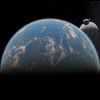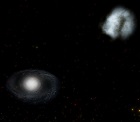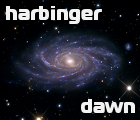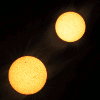|
SpaceEngine Planet Classifications
|
|
| steeljaw354 | Date: Monday, 21.12.2015, 11:08 | Message # 226 |
 World Builder
Group: Users
 Pirate
Pirate
Messages: 862
Status: Offline
| We need Carbon planets and Cthonian planets. Gas dwarfs and rouges are also needed.
|
| |
| |
| SpaceEngineer | Date: Monday, 21.12.2015, 13:41 | Message # 227 |
 Author of Space Engine
Group: Administrators
 Russian Federation
Russian Federation
Messages: 4800
Status: Offline
| Quote steeljaw354 (  ) We need Carbon planets and Cthonian planets. Gas dwarfs and rouges are also needed.
They will fit into SE classification.
Carbon - desert or titan.
Cthonian - gas giant, ice giant, oceania or desert, depending on evaporation progress.
Gas dwarf - lightweight ice giant or heavy desert with thick atmosphere.
Rouge planet - not need a separate class. Classification in SE is based on mass and temperature, so it could be any "frozen" class.

|
| |
| |
| steeljaw354 | Date: Monday, 21.12.2015, 23:12 | Message # 228 |
 World Builder
Group: Users
 Pirate
Pirate
Messages: 862
Status: Offline
| What about Y9 dwarfs what would they look like? Frozen terras? Terras with high pressure and a certain compound in water that would prevent water from freezing.
Edited by steeljaw354 - Monday, 21.12.2015, 23:14 |
| |
| |
| SpaceEngineer | Date: Monday, 21.12.2015, 23:46 | Message # 229 |
 Author of Space Engine
Group: Administrators
 Russian Federation
Russian Federation
Messages: 4800
Status: Offline
| Quote steeljaw354 (  ) What about Y9 dwarfs what would they look like?
Like temperate gas giant.
Quote steeljaw354 (  ) Frozen terras?
Like ice world or Mars-like world, depending on what is prevail on surface: show or dust.
Quote steeljaw354 (  ) Terras with high pressure and a certain compound in water that would prevent water from freezing.
Like regular terra, but with denser atmosphere.

|
| |
| |
| quarior14 | Date: Sunday, 24.01.2016, 12:53 | Message # 230 |
 World Builder
Group: Users
 Pirate
Pirate
Messages: 649
Status: Offline
| I had the idea if at the time that there will be technoniques plates (continental drift) and erupting volcanoes as if it could not be added as if the planet is active or "dead" (I implies that the planet has over erupting volcano to technoniques plates).
Then but I think it was suggested, could be added if the natural or artificial term.
Example with Earth :
Planet natural active Earth
Quarior
|
| |
| |
| SpaceEngineer | Date: Sunday, 24.01.2016, 16:14 | Message # 231 |
 Author of Space Engine
Group: Administrators
 Russian Federation
Russian Federation
Messages: 4800
Status: Offline
| Quote quarior14 (  ) I had the idea if at the time that there will be technoniques plates (continental drift) and erupting volcanoes as if it could not be added as if the planet is active or "dead" (I implies that the planet has over erupting volcano to technoniques plates).
Then but I think it was suggested, could be added if the natural or artificial term.
Example with Earth :
Planet natural active Earth
All this is good (and has been suggested million times before), but how this can be implemented in the code? Words like "feature X can be added" is just words. I need words like "feature X can be implemented using this technique < link > or this algorithm < description >". Many ideas have no transition between 1 and 2, sadly 

|
| |
| |
| Salvo | Date: Sunday, 24.01.2016, 17:46 | Message # 232 |
 Star Engineer
Group: Local Moderators
 Italy
Italy
Messages: 1400
Status: Offline
| Quote SpaceEngineer (  ) Many ideas have no transition between 1 and 2, sadly
Actually it can be implemented, but it would be so heavy for the CPU that you would require a cluster of 200 PCs to have an acceptable frame-rate!
LoL, we might open a thread about algorithms and way to implement things in SE, there are a few programmers on this forum.
The universe is not required to be in perfect harmony with human ambition.
CPU: Intel Core i7 4770 GPU: ASUS Radeon R9 270 RAM: 8 GBs
(still don't know why everyone is doing this...)
|
| |
| |
| Elenchus | Date: Saturday, 06.02.2016, 01:39 | Message # 233 |
 Observer
Group: Newbies
 United States
United States
Messages: 5
Status: Offline
| I like a lot of these suggestions, and I didn't have a chance to read through all 16 pages of this thread, but I feel like we need a separate classification for non-life bearing Terras that drops the "Terra" part entirely. I had the chance to read through this paper at work, and it makes a strong case for the rarity of a world fulfilling the criteria of being technically habitable, but devoid of life. Granted, it's theoretical, but it makes a great deal of logical sense.
The Case for a Gaian Bottleneck: The Biology of Habitability
For those who don't have the time to read the entire text, here's the abstract:
"The prerequisites and ingredients for life seem to be abundantly available in the Universe. However, the Universe
does not seem to be teeming with life. The most common explanation for this is a low probability for the
emergence of life (an emergence bottleneck), notionally due to the intricacies of the molecular recipe. Here, we
present an alternative Gaian bottleneck explanation: If life emerges on a planet, it only rarely evolves quickly
enough to regulate greenhouse gases and albedo, thereby maintaining surface temperatures compatible with liquid
water and habitability. Such a Gaian bottleneck suggests that (i) extinction is the cosmic default for most life
that has ever emerged on the surfaces of wet rocky planets in the Universe and (ii) rocky planets need to be
inhabited to remain habitable. In the Gaian bottleneck model, the maintenance of planetary habitability is a
property more associated with an unusually rapid evolution of biological regulation of surface volatiles than with
the luminosity and distance to the host star. Key Words: Life—Habitability—Gaia—Abiogenesis habitable zone
(AHZ)—Circumstellar habitable zone (CHZ). Astrobiology 16, 7–22."
A classification like "Failed Terra" seems kind of redundant, since by the logic of the paper such a world would either be long past it's period of habitability, or failed to meet conditions conducive to Abiogenesis altogether. Therefore, even if that planet is roughly approximate to Earth in terms of mass, I personally believe that it shouldn't deserve a Terra classification of any kind.
Edited by Elenchus - Saturday, 06.02.2016, 01:48 |
| |
| |
| HarbingerDawn | Date: Saturday, 06.02.2016, 01:53 | Message # 234 |
 Cosmic Curator
Group: Administrators
 United States
United States
Messages: 8717
Status: Offline
| The term "terra" as used in SpaceEngine has nothing to do with habitability. It refers only to a solid planet whose surface is partially covered in liquid water. So long as a planet meets that sole criterion, it is a terra.
All forum users, please read this!
My SE mods and addons
Phenom II X6 1090T 3.2 GHz, 16 GB DDR3 RAM, GTX 970 3584 MB VRAM
|
| |
| |
| Wicker1M | Date: Tuesday, 08.03.2016, 21:15 | Message # 235 |
 Astronaut
Group: Users
 United States
United States
Messages: 57
Status: Offline
| How about helium planets? They are hypothetical giant planets that have atmospheres depleted of hydrogen. Helium planets have atmospheres that are abundant in helium. Helium planets are white or grey in hue.
https://en.wikipedia.org/wiki/Helium_planet
To create a helium planet in Space Engine, the program could procedurally generate the circumstances that a helium planet might form. A helium planet would have an atmosphere listed as predominantly helium with abundant carbon monoxide and carbon dioxide. I think that helium planets would have cloud textures and colors in greyish and whitish hues.
|
| |
| |
| Terran | Date: Wednesday, 09.03.2016, 02:48 | Message # 236 |
 Observer
Group: Users
 United States
United States
Messages: 12
Status: Offline
| How about a sub-class name system... as in transitions in between two. For example Desert-Terra (Or some simplified name), which means terrestrial planets with liquid water on the surface but only in small amounts. Or Oceania-Terra (Island Planet). Which is a terrestrial planet with the majority of the surface water but with land still present, in the form of islands.
Also maybe a Tundra planet, like an ice world but water can still exist in all 3 phases. So with oceans and lakes bordering glaciers. Like how purple life is common on deserts, Tundras may have its own counterpart.
"To comprehend all that can be... but to not even grasp that which is..."
Processor: Intel i7 , 4 GHz | RAM: 16 GB | OS: Windows 8.1 , 64 bit | Graphics: NVIDIA GeForce GTX 960 , 2048 D.V.M. | DirectX: 11.0
|
| |
| |
| parameciumkid | Date: Wednesday, 09.03.2016, 03:19 | Message # 237 |
 Explorer
Group: Users
 United States
United States
Messages: 277
Status: Offline
| As long as I'm here:
rogue planets.
"Rouge" is a word adopted from French which means red or pink. An example of a rouge planet might be Mars or Pluto.
"Rogue" refers to something rebellious or on the loose - so a planet that has escaped into interstellar space is a rogue planet.
It is an easy typo, but after two in a row I wanted to make sure everyone actually knew how to spell it 
Intel HD Graphics 4000 ;P
|
| |
| |
| Idgelios | Date: Wednesday, 06.04.2016, 00:26 | Message # 238 |
 Astronaut
Group: Users
 United States
United States
Messages: 77
Status: Offline
| [@Elchenus]
Lifeless terras already qualify for this. If you believes terra should be rare and almost always have life, this is actually possible with the universe CFG; rig the oceania -> terra option to make terras much rarer and increase the lifeoriginpropterra section of the universe config.
|
| |
| |
| Donatelo200 | Date: Wednesday, 06.04.2016, 02:52 | Message # 239 |
|
Explorer
Group: Users
 United States
United States
Messages: 261
Status: Offline
| An interesting bug. Cold planets seem to lose almost all their atmosphere while hotter one retain it. I noticed this while looking at young systems. In those I found diverse range of planets and even some terrestrial with dense hydrogen atmospheres. Older systems have none and almost all the cold planets have lost their atmospheres, even the large ones. Hot planets seem to be relatively unaffected by age on the contrary. At least the pressures. I find the compositions change accurately.
CPU: Intel Core i7-4790K
GPU: Nvidia GTX 1080
SSD: Samsung 850 Evo 250GB
HDD: Toshiba DT01ACA200 2TB
HDD: WD Blue 1TB (2012)
RAM: Unknown 16G-D3-1600-MR 2x8GB
MBD: MSI Z97S SLI Krait Edition (MS-7922)
|
| |
| |
| PlutonianEmpire | Date: Tuesday, 12.04.2016, 06:56 | Message # 240 |
 Pioneer
Group: Users
 United States
United States
Messages: 475
Status: Offline
| How exactly does the oceania --> terra option in universe.cfg work anyway?
Specs: Dell Inspiron 5547 (Laptop); 8 gigabytes of RAM; Processor: Intel® Core™ i5-4210U CPU @ 1.70GHz (4 CPUs), ~2.4GHz; Operating System: Windows 7 Home Premium 64-bit; Graphics: Intel® HD Graphics 4400 (That's all there is :( )
|
| |
| |